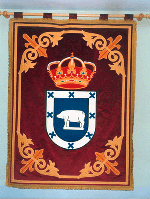The origin of El Barraco dates from the time of the "Culture of Boars" , developed by the Vettones (Celtic roots) during centuries VII to I B.C. although the lack of data in the Iron Age not allow delve deeper into their roots.

The rough granite sculptures shaped like animals ,some of them with an existence known until the second half of the 1940s, would be which gave name to this town and to our municipal shield .

Roman Empire Legions also left numerous traces of their passage through these lands. For example several bridges that still retain some of their original inscriptions, and are also visible small sections of calzadillas. Pontoons and roads, that during the boom of the late Middle Ages, were widely used by the Honourable Council of the Mesta.
Advancing our historical journey, we are aware of the presence in these domains of the Visigoths, people of Germanic descent, with a spear point found by chance some years ago by a local resident in the Iruelas Valley.
Numerous fountains and pylons sprout in different places and village squares .
The church, the old library and town hall are part of the architectural and cultural heritage of El Barraco .
Nowadays, people live mainly of livestock activity, furriers , agriculture and the service sector.
People of the town are warm and kindly enjoy sharing knowledge and experiences with visitors.
The traditional cuisine is part of this town history, where we can buy and taste the village's bread, the native pastries (donuts and fried little bones, cakes cracklings, colostrums,... ) as well as slautghter soups, roasted meat in wood-fired ovens and Avileña veal steaks.
